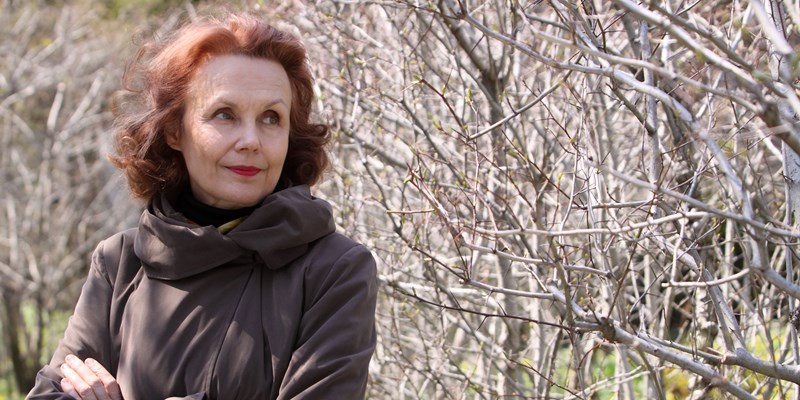
The composer Kaija Saariaho has died at the age of 70. As a tribute we republish an overview of her life and career by Guy Rickards from April 2013 below. And, as a preface, we have James Jolly's recent interview with Saariaho (for medici.tv) filmed earlier this year:
Kaija Saariaho (b1952 in Helsinki) is one of the foremost women composers on the planet and one of the leading creative figures of her generation of either gender; a truly original artist with a very distinctive musical style and personal voice, developed and refined over decades. The awards she has received over the years are indicative of this, including the Kranichsteiner Prize (1986), the Nordic Council Music Prize (2000, for Lonh), the Grawemeyer (2003, for her first opera, L’amour de loin), the Nemmers Prize in Composition (2007), the Wihuri Sibelius Prize (2009) and the Léonie Sonning Music Prize (2011).
Yet she is also a very private person, with much about her biography that is largely unknown, not least that she was born Kaija Laakkonen: the ‘trademark’ name of Saariaho is her first husband’s. She studied with Heininen at the Sibelius Academy, with other members of a miraculous generation of Finnish composers including Esa-Pekka Salonen and Magnus Lindberg. Further studies followed with Brian Ferneyhough and Klaus Huber; equally formative influences were Tristan Murail and Gérard Grisey, the principal exponents of spectral music (music placing timbre and sound ahead of other compositional considerations), leading her to IRCAM and 30 years’ residence in Paris, latterly with her second husband, Jean-Baptiste Barrière. Although she made an initial breakthrough with the orchestral Verblendungen (1984), it was with her dazzling, enchanting nonet-with-electronics Lichtbogen (‘Arches of Light’, 1986) that she burst onto the wider scene. Its ethereal, hypnotic textures were inspired by the aurora borealis, and the use of electronics proved prophetic for her future career. More important still was the combination of sonic delicacy and an inner steel – which makes her works beguiling to the ear yet robust and compelling as structures.
Building on the success of Lichtbogen, Saariaho has composed a further 100-plus works for the widest variety of forces, from full-scale opera to instrumental solos. Yet Saariaho has fought shy of many of the standard Classical forms, such as sonata, symphony, trio and quartet. There are two unconventional works for string quartet, Nymphéa (subtitled Jardin secret III, with a large electronic component, 1987) and Terra memoria (2006), both later reworked for string orchestra (Nymphéa as Nymphéa Reflection in 2001). Her instrumental output includes many vivid works with illustrative titles, such as Io (1987), Solar (1993) and Orion (2002). Even in her concertos, the one conventional genre she has cultivated, the inner structures are highly unconventional, each work deriving its form from particular sound combinations or the nature of the instruments being written for (including the human voice). This was demonstrated early on in her hybrid orchestral diptych Du cristal… á la fumée (1989-90), where …á la fumée is a single-span double concerto for alto flute and cello, the concerto ‘form’ emerging out of the purely orchestral Du cristal.
Later concertos have followed highly individual and imaginative courses: Amers (1992, for cello), Graal théâtre (1994, for violin; also in a reduced arrangement, 1997), Aile du songe (2001, for flute – an instrument that features prominently throughout her catalogue) and, most recently, D’om le vrai sens, the clarinet concerto written in 2010 for Kari Kriikku. While timbre and the nature of sound, rather than established musical forms from the past, give Saariaho’s music its inner framework, the results are not haphazard or quixotic. Saariaho has used computer-driven analyses, sound patterns, chords or instrumental combinations to assist in selecting the appropriate structures for her music. While this might seem mechanical, almost an abdication of the composer’s primary role in creativity, in Saariaho’s case it is a liberating method, allowing her new means and avenues for her musical intuition to follow.
Expressivity is all, and this is nowhere more apparent than in the string of vocal works that she’s written since the late 1980s, such as Grammaire des rêves (1988), Nuits, adieux (1991), Lonh (1996), Oltra mar (1999), the oratorio La passion de Simone (2006) and Leino Songs (2007). The apex of her output, however, is undoubtedly her operas (all with librettos by Amin Maalouf), starting in 2000 with L’amour de loin, a powerful and mesmerising tale of unrequited, chivalric love set during the Crusades. This work has rightly garnered considerable acclaim, with two fine sound recordings (plus one on DVD) bringing Saariaho to the attention of a still wider audience. Two further operas, Adriana mater (2005) and Emilie (2008), have refined her operatic sensibilities further, but it is L’amour that remains the pivotal work in her output, a fact Saariaho herself acknowledges: ‘Everything I had written up to that moment was in that piece. All the material, my approach to harmony, to texture – all of it was there. And so after the opera, I somehow felt that I was starting again.’
No comments:
Post a Comment